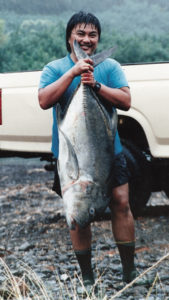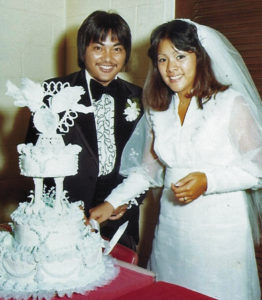Alvin Michael Cortez
Lucy Peros | All photos courtesy Alvin Cortez ‘Ohana
“A happy childhood is perhaps the most fortunate gift in life,” British author and journalist Dorothy Richardson once said.
This month’s featured Sakada Offspring, Alvin Michael Cortez shared his happy and memorable childhood he inherited from his old timer Sakada grandpa, Mariano Patao who came from the Philippines in the 1920’s and from his 1946 Sakada Dad, Pedro “Martin” “Pete” Cortez.


Alvin Cortez was born in Pu‘unēnē, Maui in August 1952 to Pedro Cortez and Dolinda Patao Cortez. Alvin attended Pu‘unēnē Elementary from 1957, transferred to Kahului Elementary in 1959, then to Lihikai Elementary in 1960 and attended St. Anthony High School Boys Department from 1966–1970. He attended Seattle University in 1970 and 1971. He moved back to Maui, enrolled at Maui Community College (now U.H. Maui College) from 1971–1973 and graduated.
Alvin is the eldest of seven siblings. Next is Daniel Cortez who is retired from the construction industry. He and his wife Terry who works at Pukalani Superette have one daughter Danzelle who attends King Kekaulike High School. The next sibling is Robin Cortez who is retired from UPS. He is married to Joni DeMello who works at HI Tech. Next is Glen Cortez who retired from Kula Produce. And next is Gil Cortez, who works at Service Rentals. Alvin has two sisters, Leilani who is employed at the Grand Wailea Resort and Alisa who is employed at Andaz in Wailea. Alisa has two daughters Sydney and Jeni and one grandson, Ezekiel.

Alvin worked at the Maui Land and Pineapple fields and cannery as soon as he turned 15. “The experience taught me the value of hard work and made me more appreciative for my parents who worked hard to put a roof over our heads and food on the table.”
After graduating from Maui Community College, Alvin was employed at the old Woolworths store at Maui Mall helping them set up the store from the ground up. He also worked at First Hawaiian Bank, Maui Hog Producers (owned by the late Mayor Elmer Cravalho), and in 1974, he finally landed a job with the County of Maui as a file clerk with the Mayor’s Office on a federal grant. In 1975, Alvin became a permanent employee with the Department of Finance Payroll Division. In 1976, he transferred to the Department of Motor Vehicles as a Driver Examiner until he retired in 2018.

Alvin married the former Stephanie Pagay of Lāna‘i in 1976. They were brought up and raised from the same plantation town background where you knew everyone. Lāna‘i was known as the largest pineapple plantation in Hawai‘i. Alvin and Stephanie have two daughters, Nicole and Rhiana. Nicole graduated from the University of Hawai‘i at Mānoa. She is employed at the County of Maui Council Services. She is married to Angel Kahinu. Their daughter Rhiana attended University of Hawai‘i Maui College and works for 5 Palms in Wailea.

Stephanie and Alvin lived in Ha‘ikū for 35 years before moving to Wailuku prior to his retirement. They were members of St. Rita’s Catholic Church in Ha‘ikū and very involved in the church ministries presenting parish retreats and Choice, a gathering for young adults.
After the death of Alvin’s father, Pedro Cortez, Stephanie and Alvin traveled from Ha‘ikū to make sure his mom Dolinda attended mass at Christ The King Catholic Church, where Pedro and Dolinda were lifetime members. Presently, Stephanie and Alvin are serving as Lectors at Christ The King Church. They wanted to give back to the community that received them as new members of the parish with open arms and kindness.
Going down memory lane, Alvin said his family lived in Pu‘unēnē Spanish B Camp among people of different races, close to the Pu‘unēnē School and Holy Family Catholic Church. He and his brothers, Daniel and Robin would spend quite a bit of time with their grandparents Mariano and Felisa Patao in Waihe‘e. They would accompany their grandpa to feed pigs in his old Willys army jeep. Since they lived close to the beach at Waihe‘e, the boys were able to take part in the hukilau (community gathering fish with fishnets). They usually received their share of the catch by helping. Grandpa Mariano worked for Wailuku Sugar Company and Waihe‘e Dairy. He raised cattle, hogs, chickens, and goats. He was an expert fisherman and good gatherer of wild vegetables in the mountain valleys.

Before Queen Ka‘ahumanu Center was built, the three Cortez boys would ride their bikes or walked from their Kaiemi Street home to go fishing at the Kahului Harbor.
Alvin shared his fun memories of the past. He enjoyed hunting, fishing, diving, camping, hanging out at the beach and spending time with family. The entire Cortez clan and close friends would go on yearly camping trips mostly at Honomanū Bay in Ke‘anae. They would have canoe rides and catch o‘opu (fresh-water fish) in the river using earth worms that Grandpa Mariano Patao dug up. According to Alvin, it was at Honomanū Bay that he caught his first ulua!

When their children were younger, Alvin and Stephanie took them to Disneyland, Las Vegas and San Francisco. They enjoyed the rides at Disneyland where they ate their first churros (Mexican stick doughnuts). In 2008, Stephanie and Alvin were fortunate to take a trip to China. There they experienced climbing the Great Wall of China, seeing the thousands of stone warrior statues and excavation sites in Xian, eating lots of delicious Chinese food, and shopping. They also visited Beijing, Suzhou, and Shanghai.

Alvin and Stephanie enjoyed their many trips to Lāna‘i to visit Stephanie’s parents and relatives. Alvin reminisces when he and his father-in-law went on a fishing trip on his boat catching aku, kawakawa, and mahimahi. He even learned from his father-in-law how to look for and catch tako (octopus) in the shallow waters of Lāna‘i.

Alvin was more than happy to share his reflection on his job as a Driver Examiner. Working at the Department of Motor Vehicles (DMV) afforded Alvin a lot of interesting encounters with the public. “When taking a driver on the road test, I try to make them as comfortable as possible. When a person tells me that they’ve tried a number of times to get their license and failed, I try to lighten the encounter by telling them, ‘maybe you should ride a bike.’ They usually laugh and feel a little more at ease. When a driver failed the test, I would try to take a little time letting them know what they did wrong and how to correct their mistakes. I would often get reprimanded for taking ‘a little too long’ doing tests. I remember that I’m a public servant and should offer my assistance to help and encourage the drivers to do better and become good drivers on Maui County roads.”

One of Alvin’s role models in life is his father, the late Pedro Cortez, a 1946 Sakada. This writer had the privilege of talking with him when he was still alive. Pedro shared he was one of the first batches of the 1946 Sakadas who came to Hawai‘i to work in the sugar and pineapple plantations. He was born on July 19, 1926 in Paing, Bantay, Ilocos Sur, Philippines. He was a young man of 19 when he boarded SS Maunawili at Port Salomague to come to Hawai‘i on December 15, 1945. He remembered being transported to the SS Maunawili on a raft and climbing up on a rope because Port Salomague was too shallow for big boats to land. He signed up to come to Hawai‘i to find a better life for him and his family.


The boat ride to Hawai‘i was not always pleasant. Many of the men got seasick throughout the rough voyage. Someone even died on the boat according to Pedro. They couldn’t keep the dead body on board and it was too far to go back to the shore. So, the dead body was buried at sea.

On January 1,1946, SS Maunawili stopped in Hilo, Hawai‘i to drop off some of the Sakadas and on the next day, January 2, 1946, it arrived at Kahului Harbor. A Hawaiian Commercial & Sugar (HC&S) truck was waiting for the Sakadas to transport them to their designated camps. They were first taken to Spanish B and at “Hale Ono,” an eatery to eat breakfast. There, they were given their supplies such as a kerosene stove, blanket, and a bag of rice. On January 3, 1946, Pedro reported to work in the sugarcane field. His jobs at HC&S consisted of cutting grass, cutting cane with cane knife (stalks for planting). “It was a hard job,” Pedro sighed.
After Spanish B, Pedro lived at Camp 3, a camp near Spreckelsville and at Camp 5 near the Holy Family Catholic Church in Pu‘unēnē. Anything they bought from Camp 5 Store was paid through credit, meaning the charges were deducted from their paycheck every month. All they had to do was to present their bango number.

Pedro lived in a two-bedroom plantation house with other Sakadas like the late Juan Obrero and Estaquio Cortez. They had fun living in the camp with lots of activities especially dances according to Pedro.
Pedro was a handsome young man. There was a woman named Feliza Patao who was working at the old Kress Store in Wailuku. She had a beautiful daughter. When she spotted Pedro at the store, she had a good idea of becoming a matchmaker. So, she arranged a way for Pedro to meet her daughter, Dolinda Patao. It worked! Although Dolinda did not care too much about Pedro at first, their love grew as time went by. Their courtship blossomed and in 1952, they got married at St. Ann’s Church and had their reception at the Pu‘unēnē Filipino Clubhouse. Their love produced seven children as mentioned by Alvin.

Pedro and Dolinda Cortez enjoyed traveling. They enjoyed ballroom dancing and participated in showcases even as far as Las Vegas. Pete and Dolinda were a couple who enjoyed life together and became a good role model for their seven children.
Pedro’s advice to young people was to get a good education because a good education guides everyone to find a better job. To older people like him, he said to take good care of oneself through exercise and watch what to eat.
Alvin’s own advice is “There should be a balance between attaining your life goals and aspirations and trying to maintain a spiritual life; for man’s wisdom is foolishness in God’s eyes.”


Lucy Peros is a retired school teacher, having taught at St. Anthony Grade School and Waihe‘e Elementary School. Both of her parents, Elpidio Cachero Cabalo (a 1946 Sakada) and Alejandra Cabudoy Cabalo of Hāli‘imaile worked for Maui Land and Pine Company. Lucy now enjoys retirement and has time to join other seniors in the Enhance Fitness Program under the Department of Aging three times a week. She also attends the line dancing class and other activities at Kaunoa and joins other Waihe‘e School retirees when help is needed at the school. Lucy also devotes some of her time to activities at Christ The King Catholic Church. She enjoys writing and reading in her spare time.
